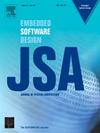Scheduling virtual machines and containers: A comparative review of techniques, performance, and future trends
IF 4.1
2区 计算机科学
Q1 COMPUTER SCIENCE, HARDWARE & ARCHITECTURE
引用次数: 0
Abstract
Virtual machines (VMs) and containers underpin modern cloud infrastructures through distinct virtualization mechanisms, yet their scheduling strategies remain theoretically disconnected. Existing studies often address each paradigm in isolation, overlooking shared system-level challenges and conceptual overlaps. In this survey, we offers a virtualization-agnostic perspective by introducing a layered abstraction of scheduling, encompassing task dispatch, instance placement, and resource provisioning. We use this taxonomy to systematically compare five popular scheduling paradigms – mathematical modeling, heuristics, meta-heuristics, machine learning, and hybrids – on VM and container domains. Instead of enumerating techniques, our comparison emphasizes methodological convergence, indicating shared trade-offs guided by deployment granularity, orchestration flexibility, and performance isolation.
By projecting scheduling classes onto workload sensitivities, we provide context-specific guidance that connects theoretical research to practical configurations. Further, the research explains high-level algorithmic trends which indicate a shift away from isolated techniques to integrated orchestration systems. In this comparative viewpoint, the paper redefines VM and container scheduling as structurally equivalent problems with equivalent constraints and objectives. The outcomes are designed to help system designers and researchers design scheduling solutions that are both platform-adaptive and workload-responsive in heterogeneous computing systems.
调度虚拟机和容器:技术、性能和未来趋势的比较回顾
虚拟机(vm)和容器通过不同的虚拟化机制支撑现代云基础设施,但它们的调度策略在理论上仍然是断开的。现有的研究往往孤立地处理每个范例,忽视了共同的系统级挑战和概念重叠。在本调查中,我们通过引入调度的分层抽象,包括任务分派、实例放置和资源供应,提供了一个与虚拟化无关的视角。我们使用这个分类法系统地比较了五种流行的调度范式——数学建模、启发式、元启发式、机器学习和混合模式——在VM和容器领域。我们的比较没有列举技术,而是强调方法的收敛,指出了由部署粒度、编排灵活性和性能隔离指导的共享权衡。通过将调度课程投射到工作负载敏感性上,我们提供了将理论研究与实际配置联系起来的特定于上下文的指导。此外,该研究还解释了高级算法趋势,表明从孤立的技术转向集成的编排系统。在这种比较的观点下,本文将虚拟机和容器调度重新定义为具有等效约束和目标的结构等效问题。研究结果旨在帮助系统设计者和研究人员在异构计算系统中设计既能适应平台又能响应工作负载的调度解决方案。
本文章由计算机程序翻译,如有差异,请以英文原文为准。
求助全文
约1分钟内获得全文
求助全文
来源期刊

Journal of Systems Architecture
工程技术-计算机:硬件
CiteScore
8.70
自引率
15.60%
发文量
226
审稿时长
46 days
期刊介绍:
The Journal of Systems Architecture: Embedded Software Design (JSA) is a journal covering all design and architectural aspects related to embedded systems and software. It ranges from the microarchitecture level via the system software level up to the application-specific architecture level. Aspects such as real-time systems, operating systems, FPGA programming, programming languages, communications (limited to analysis and the software stack), mobile systems, parallel and distributed architectures as well as additional subjects in the computer and system architecture area will fall within the scope of this journal. Technology will not be a main focus, but its use and relevance to particular designs will be. Case studies are welcome but must contribute more than just a design for a particular piece of software.
Design automation of such systems including methodologies, techniques and tools for their design as well as novel designs of software components fall within the scope of this journal. Novel applications that use embedded systems are also central in this journal. While hardware is not a part of this journal hardware/software co-design methods that consider interplay between software and hardware components with and emphasis on software are also relevant here.
 求助内容:
求助内容: 应助结果提醒方式:
应助结果提醒方式:


